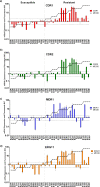A Combination Fluorescence Assay Demonstrates Increased Efflux Pump Activity as a Resistance Mechanism in Azole-Resistant Vaginal Candida albicans Isolates
- PMID: 27431223
- PMCID: PMC5038269
- DOI: 10.1128/AAC.01252-16
A Combination Fluorescence Assay Demonstrates Increased Efflux Pump Activity as a Resistance Mechanism in Azole-Resistant Vaginal Candida albicans Isolates
Abstract
Candida albicans is a pathogenic fungus causing vulvovaginal candidiasis (VVC). Azole drugs, such as fluconazole, are the most common treatment for these infections. Recently, azole-resistant vaginal C. albicans isolates have been detected in patients with recurring and refractory vaginal infections. However, the mechanisms of resistance in vaginal C. albicans isolates have not been studied in detail. In oral and systemic resistant isolates, overexpression of the ABC transporters Cdr1p and Cdr2p and the major facilitator transporter Mdr1p is associated with resistance. Sixteen fluconazole-susceptible and 22 fluconazole-resistant vaginal C. albicans isolates were obtained, including six matched sets containing a susceptible and a resistant isolate, from individual patients. Using quantitative real-time reverse transcriptase PCR (qRT-PCR), 16 of 22 resistant isolates showed overexpression of at least one efflux pump gene, while only 1 of 16 susceptible isolates showed such overexpression. To evaluate the pump activity associated with overexpression, an assay that combined data from two separate fluorescent assays using rhodamine 6G and alanine β-naphthylamide was developed. The qRT-PCR results and activity assay results were in good agreement. This combination of two fluorescent assays can be used to study efflux pumps as resistance mechanisms in clinical isolates. These results demonstrate that efflux pumps are a significant resistance mechanism in vaginal C. albicans isolates.
Copyright © 2016, American Society for Microbiology. All Rights Reserved.
Figures





Similar articles
-
Activity of Isavuconazole and Other Azoles against Candida Clinical Isolates and Yeast Model Systems with Known Azole Resistance Mechanisms.Antimicrob Agents Chemother. 2015 Oct 19;60(1):229-38. doi: 10.1128/AAC.02157-15. Print 2016 Jan. Antimicrob Agents Chemother. 2015. PMID: 26482310 Free PMC article.
-
The anti-staphylococcal fusidic acid as an efflux pump inhibitor combined with fluconazole against vaginal candidiasis in mouse model.BMC Microbiol. 2024 Feb 10;24(1):54. doi: 10.1186/s12866-024-03181-z. BMC Microbiol. 2024. PMID: 38341568 Free PMC article.
-
Mechanisms of resistance to azole antifungal agents in Candida albicans isolates from AIDS patients involve specific multidrug transporters.Antimicrob Agents Chemother. 1995 Nov;39(11):2378-86. doi: 10.1128/AAC.39.11.2378. Antimicrob Agents Chemother. 1995. PMID: 8585712 Free PMC article.
-
Antifungal drug resistance in pathogenic fungi.Med Mycol. 1998;36 Suppl 1:119-28. Med Mycol. 1998. PMID: 9988500 Review.
-
Candida Efflux ATPases and Antiporters in Clinical Drug Resistance.Adv Exp Med Biol. 2016;892:351-376. doi: 10.1007/978-3-319-25304-6_15. Adv Exp Med Biol. 2016. PMID: 26721282 Review.
Cited by
-
Enhanced Efflux Pump Activity in Old Candida glabrata Cells.Antimicrob Agents Chemother. 2018 Feb 23;62(3):e02227-17. doi: 10.1128/AAC.02227-17. Print 2018 Mar. Antimicrob Agents Chemother. 2018. PMID: 29311061 Free PMC article.
-
Healthy Vaginal Microbiota and Influence of Probiotics Across the Female Life Span.Front Microbiol. 2022 Apr 8;13:819958. doi: 10.3389/fmicb.2022.819958. eCollection 2022. Front Microbiol. 2022. PMID: 35464937 Free PMC article. Review.
-
Novel ABC Transporter Associated with Fluconazole Resistance in Aging of Cryptococcus neoformans.J Fungi (Basel). 2022 Jun 28;8(7):677. doi: 10.3390/jof8070677. J Fungi (Basel). 2022. PMID: 35887434 Free PMC article.
-
Virulence Factors as Promoters of Chronic Vulvovaginal Candidosis: A Review.Mycopathologia. 2021 Dec;186(6):755-773. doi: 10.1007/s11046-021-00592-8. Epub 2021 Oct 6. Mycopathologia. 2021. PMID: 34613569 Review.
-
Transport across Membranes: Techniques for Measuring Efflux in Fungal Cells.Methods Mol Biol. 2023;2658:201-213. doi: 10.1007/978-1-0716-3155-3_14. Methods Mol Biol. 2023. PMID: 37024704
References
-
- Sobel JD, Zervos M, Reed BD, Hooton T, Soper D, Nyirjesy P, Heine MW, Willems J, Panzer H. 2003. Fluconazole susceptibility of vaginal isolates obtained from women with complicated Candida vaginitis: clinical implications. Antimicrob Agents Chemother 47:34–38. doi:10.1128/AAC.47.1.34-38.2003. - DOI - PMC - PubMed
MeSH terms
Substances
LinkOut - more resources
Full Text Sources
Other Literature Sources

